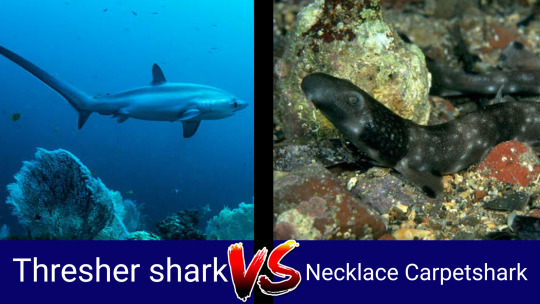#Parascyllium variolatum
Text


Necklace carpet shark (Parascyllium variolatum)
Size: Up to 90 cm (35 in)
Range & Habitat: Necklace carpetsharks are found in the waters that surround eastern Australia. They typically live in shallow water, resting on the seafloor.
Other: The necklace carpetshark can be identified by its band patterns, elongated body, and its namesake black spotted “necklace.” It is nocturnal, but prefers to hide in crevasses most of the time.
236 notes
·
View notes
Text

You already know them, now lets facts.
The leopard shark (Triakis semifasciata) the carpet shark may be a coral reef shark, but this one prefers sandy flats or kelp "forests". In captivity, larger leopard sharks establish their dominance over the smaller ones by light bites on their fins.
Necklace carpet shark (Parascyllium variolatum) differently to most sharks but just as most carpet sharks, is a nocturnal shark. Most sharks get active during the dawn or dusk, but not this little fella. During the day it stays on the ocean floor camuflated or in caves.
41 notes
·
View notes
Text
Carpet sharks are sharks classified in the order Orectolobiformes /ɒrɛkˈtɒləbɪfɔːrmiːz/. Sometimes the common name "carpet shark" (named so because many species resemble ornately patterned carpets) is used interchangeably with "wobbegong", which is the common name of sharks in the family Orectolobidae. Carpet sharks have five gill slits, two spineless dorsal fins, and a small mouth that does not extend past the eyes. Many species have barbels.
The carpet sharks are a diverse group of sharks with differing sizes, appearances, diets, and habits. They first appeared in the fossil record in the Early Jurassic; the oldest known orectolobiform genera are Folipistrix (known from Toarcian to Aalenian of Belgium and Germany), Palaeobrachaelurus (Aalenian to Barremian) and Annea (Toarcian to Bajocian of Europe).[1] All species have two dorsal fins and a relatively short, transverse mouth that does not extend behind the eyes. Besides the nostrils are barbels, tactile sensory organs, and grooves known as nasoral grooves connect the nostrils to the mouth. Five short gill slits are just in front of the origin of the pectoral fin and the fifth slit tends to overlap the fourth one.[2] A spiracle occurs beneath each eye which is used in respiration. The only exception to this rule is the whale shark, the spiracles of which are situated just behind the eyes.[3] Carpet sharks derive their common name from the fact that many species have a mottled appearance with intricate patterns reminiscent of carpet designs. The patterning provides camouflage when the fish is lying on the seabed.[4] The largest carpet shark is the whale shark (Rhincodon typus) which can grow to a length of 14 m (46 ft). It is the largest species of fish, but despite its size, is not dangerous, as it is a filter feeder, drawing in water through its wide mouth and sifting out the plankton. The smallest carpet shark, at up to about 30 cm (12 in) long, is the barbelthroat carpet shark, (Cirrhoscyllium expolitum).[3] Some of the most spectacularly coloured members of the order are the necklace carpet shark (Parascyllium variolatum), the zebra shark (Stegostoma fasciatum), and the ornate wobbegong (Orectolobus ornatus). Nurse sharks and whale sharks have a fringe of barbels on their snouts, and barbelthroat carpet sharks (Cirrhoscyllium expolitum) have barbels dangling from their throat regions
@remen-nyoodless @chartreuse-blood
12 notes
·
View notes
Text

And now meet our contestants.
Both the Carpetsharks and the dogfish are very cool and i separated an species for them i found fun to show. On one side, this shark doesn't look like a shark at all with it's body being slim like a snake's, and on the other this one DOES look like a shark but its face look like it has seen things™.
Some facts:
Necklace Carpetshark (Parascyllium variolatum): as almost every weird animal around, it lives on Australia, they reach only up to 91 centimeters (2.9ft). Because of their size they're really not a danger to humans, and their diet is mainly shellfish.
Smooth Dogfish (Mustelus canis): this shark has the hability of changing their color to help sith camouflage, not as much as you see some other animals like the octopus doing it, but it's still impressive. They can reach up to 1,52 meters (5ft). Their teeth are kind of blunt so they're no danger to humans.
30 notes
·
View notes
Text

Thresher Shark (genus: alopias): The thresher shark is fast and has a very fun big tail, used as a whip to hit prey and stun them. The largest species, Alopias vulpinus, can reach up to 6,1 meters (20ft). They're pretty shy and not a danger to humans. They're fished a lot for the challenge of it's speed and strenght.
Necklace Carpetshark (Parascyllium variolatum): as almost every weird animal around, it lives on Australia, they reach only up to 91 centimeters (2.9ft). Because of their size they're really not a danger to humans, and their diet is mainly shellfish.
35 notes
·
View notes